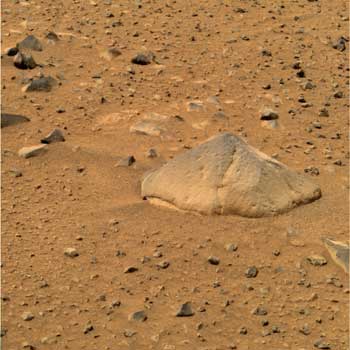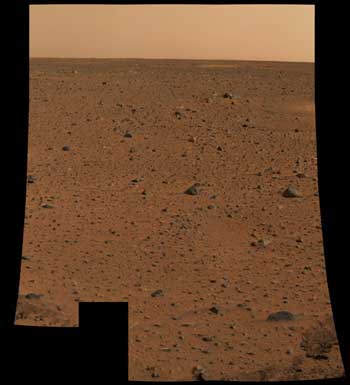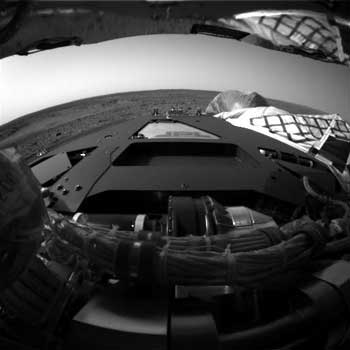|
NASA's Spirit Rover is
providing a lesson to aspiring digital photographers:
Spend your money on the lens, not the pixels.
 Anyone who has ever agonized over whether to buy a
3-megapixel or 4-megapixel digital camera might be
surprised to learn that Spirit's stunningly detailed
images of Mars are made with a 1-megapixel model, a
palm-sized 9-ounce marvel that would be coveted in any
geek's shirt pocket. Anyone who has ever agonized over whether to buy a
3-megapixel or 4-megapixel digital camera might be
surprised to learn that Spirit's stunningly detailed
images of Mars are made with a 1-megapixel model, a
palm-sized 9-ounce marvel that would be coveted in any
geek's shirt pocket.
Spirit's images are IMAX quality, mission managers
say.
The word pixel is derived from the term "picture
element." A pixel is the smallest dot of
information that goes into making a digital image. One
megapixel is a million pixels set up in an array equal
to 1,000 by 1,000.
Intuitively, more pixels means higher resolution.
That's generally true on a display screen. But when
capturing images, where a pixel is more properly called
a sensor, the count is just one of many factors that
control quality.
Seeking perfection
The technology used to make Spirit's Panoramic
Camera, or Pancam, is essentially the same as what goes
into a Casio or Pentax digital camera.
But the Pancam's lenses -- there are two, which
provides stereo imaging capability -- are crafted more
finely than anything you'd probably want to plunk down a
Visa for. And the light-capturing chunk of silicon,
called a charged coupled device, or CCD, was
manufactured with no tolerance for the minor flaws that
are inherent in mass-produced consumer cameras.
Perhaps most important, the sensors on Spirit's CCDs
are bigger, explained Patrick Myles, director of
corporate communication at the Dalsa Corporation, which
built the CCDs for all of the rover's cameras (Spirit
has nine altogether, including hazard avoidance cameras
and a microscopic imager).
 A Sony DSC-F717, with a street price of around $600,
has 5.2 million sensors (or 5 megapixels) on a chip that
is 8.8 by 6.6 millimeters (or .35 by .26 inches). The
Pancam has just a million sensors spread across a chip
that's 12 by 12 millimeters -- nearly a half-inch
square. A Sony DSC-F717, with a street price of around $600,
has 5.2 million sensors (or 5 megapixels) on a chip that
is 8.8 by 6.6 millimeters (or .35 by .26 inches). The
Pancam has just a million sensors spread across a chip
that's 12 by 12 millimeters -- nearly a half-inch
square.
Each tiny Pancam sensor, measured in microns, is
nearly four times as big as those on the Sony.
In the consumer market, which Dalsa does not target,
5-megapixel cameras often use the same size CCD as a
3-megapixel camera. More pixels are simply crammed onto
the same-size chip.
"The pixels themselves get smaller," Myles
said. "This has an impact on image quality."
Why? For one thing, smaller pixels are less
light-sensitive.
Also, the lens quality might not support the
additional pixels. As the receptors get smaller, a
higher quality lens is needed to properly focus light
onto each pixel. So where each pixel ought to capture
different light information -- say perhaps a subtle
shading change on the subject's cheek -- the same
information can get spread across several pixels after
passing through a lower quality lens.
20-20 vision
 The Pancam was conceived at Cornell University and
built at NASA's Jet Propulsion Laboratory. Dalsa, based
in Waterloo, Ontario, Canada, makes cinema-quality video
components and other high-end imaging devices and was
called on to make the CCDs for the Pancam and the other
cameras on Spirit and its twin rover, Opportunity. The Pancam was conceived at Cornell University and
built at NASA's Jet Propulsion Laboratory. Dalsa, based
in Waterloo, Ontario, Canada, makes cinema-quality video
components and other high-end imaging devices and was
called on to make the CCDs for the Pancam and the other
cameras on Spirit and its twin rover, Opportunity.
"They are the world's highest performing chips
in terms of light sensitivity and chip quality,"
Myles said in a telephone interview earlier this week.
Overall, how does a Pancam stack up to the typical
5-megapixel camera you might purchase at Best Buy?
"There really isn't any comparison," Myles
said.
NASA officials say the
camera shows what a human with 20-20 vision would see on
the surface of Mars. But anyone who has zoomed
in on a distant
rock in one of Spirit's color pictures would have to
wonder if perhaps Superman's vision might be a better
comparison.
Experts argue endlessly about what the human eye can
actually see, however. Comparing human vision to what a
camera captures "is really up to great
speculation," Myles said.
NASA's analogy, Myles explained, is "probably a
bit of marketing spin. It helps people visualize the
quality." The height and breadth of a Pancam image
is roughly equal to what a person would see, taking into
account peripheral vision. And the Pancam has a human
perspective. It sits atop a mast on the rover, 5 feet
(1.4 meters) above the surface.
Myles said the actual
image quality probably exceeds human capabilities,
especially after the image is processed and a computer
is used to provide a zoom
function.
Tricks with light
The Pancam does not make
a color picture directly. Instead, it records light
versus dark in shades of gray. As with other CCD cameras
used in high-end astrophotography, such as on the Hubble
Space Telescope,
a series of filters are applied to gather multiple
images that are then blended together.
In the most basic application of this process, three
images are gathered of a scene, one each recording red,
green and blue light. Those are then put together with
special software to create a color picture.
A consumer digital camera uses a single coated filter
to make the transition from photon reality to electrons
and then digital information.
Additionally, the Pancam
swivels 360 degrees around and 90 degrees up or down, so
that individual scenes can be stitched together to
create a view of the rover's entire
surroundings. The
pictures are expected to reveal important geologic
details about rocks, and they're also used for
navigation and to pick distant science targets.
Modern Ansel Adams
Spirit's pictures are said to be three times sharper
than those of the 1997 Mars Pathfinder mission or the
1970s Viking landers.
The Viking missions, as well as the Voyager missions
to the outer planets, used technology similar to
antiquated television vacuum tubes. CCD technology was
first developed in 1969, but it took decades before
arrays were big enough to be useful.
Much of the research that ultimately led to today's
commercial digital cameras was funded by NASA. A first
major step was in developing an 800 by 800 pixel array
-- less than a megapixel -- which is what's in the
Hubble telescope.
The Pancam results so far have mission managers
ecstatic. Cornell astronomer James Bell, who led the
development of the camera, called the first Spirit
pictures "absolutely spectacular."
Nobody has argued with him.
In fact, Steven Squyres, a Cornell professor who
directs the rover science team, called Bell "the
Ansel Adams of the Space Age."
|